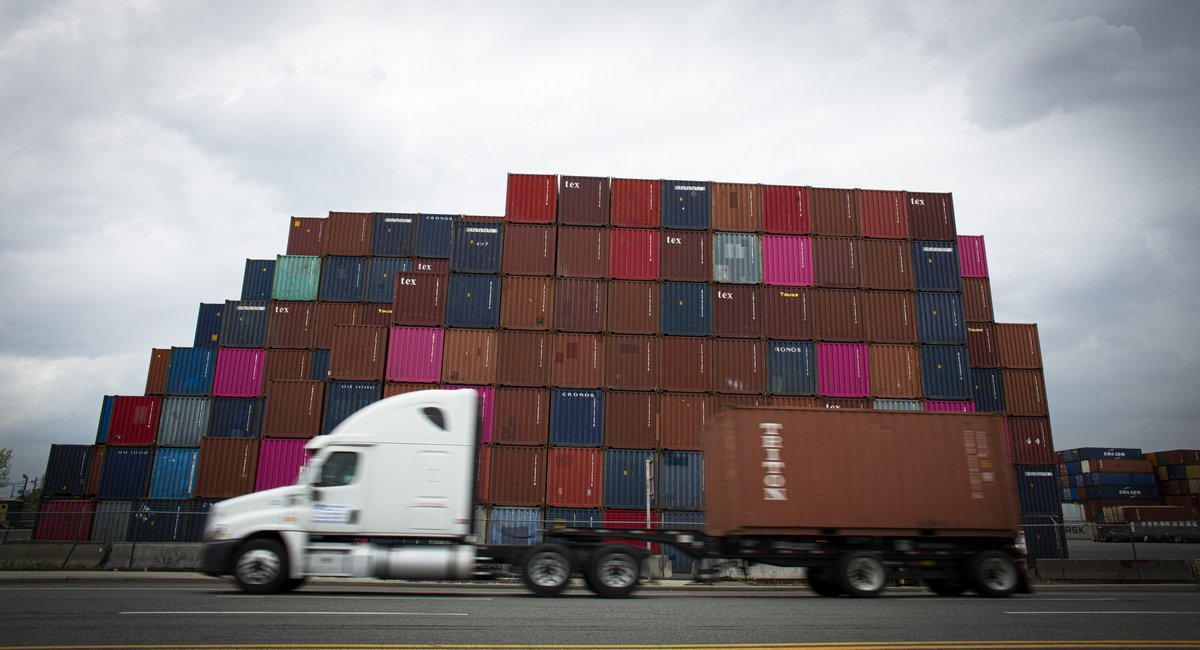The collapse of the Francis Scott Key Bridge in Baltimore caused a spike in the number of trucks rolling in and out of New York Harbor’s seaports, according to Port Authority data.
Baltimore’s port closed on March 26 after a cargo vessel struck one of the bridge’s support columns, causing the whole crossing to collapse. Cargo ships were unable to move in or out of the waterway until June 12, when the wreckage was cleared.
The problem could have undermined supply chains and the flow of goods across the East Coast had it not been for the seaports in New York and New Jersey, which handled an increase in daily cargo nearly equivalent to what Baltimore handled before its port closed. Officials with the Port Authority of New York and New Jersey said the seaports processed an additional 79,000 containers — or “20-foot equivalent units” — in May as a result of the bridge collapse. By comparison, the port in Baltimore moved about 95,000 units per month before the bridge collapsed.
“What would typically happen is we take 60% to 65% of ship’s capacity off at our terminals here before they go on to other ports,” Bethann Rooney, the Port Authority’s port director, wrote in a press release three weeks after the collapse. “Now, we’re going to take 70% to 75% of the ship’s capacity off here.”
The additional containers led to 45,000 more truck trips in and out of New York and New Jersey’s ports in May, or an increase of about 1,400 per day, data shows. The figures, while large, only represent about a 10% increase.
The work helped support the region’s economy, but it’s been troubling for residents of Elizabeth and Newark, whose ports handle the vast majority of the harbor’s shipping activity.
The seaports were already among the busiest in the nation. And Kim Gaddy, founder of the Newark environmental advocacy group South Ward Environmental Alliance, said the extra trucks could make the area’s air quality even worse.
“It’s the diesel death zone for our residents here in the South Ward and those connecting ports,” said Gaddy, whose organization is pushing for the Port Authority to invest in clean energy alternatives to gas-burning trucks.
“We want to protect the health of our residents and we don’t want it to be at the expense of the economic region,” she said. “We want to make sure that we can have a healthy and thriving and vibrant community, as well as a thriving port.”
Rooney said in a statement she recognizes the environmental challenges at the seaports.
“We know the activity at our port facilities has a broad impact across the region, but it can also have a very local impact in nearby communities,” Rooney said.
Port Authority officials said trucks leaving ports in the two states head in all directions within a four-hour drive, supporting the economy of a region that’s home to 46 million people.
Clinton Andrews, director of Rutgers University’s Center for Urban Policy Research, said people closest to the ports are breathing “highly localized” particulate pollution, or unburned carbon that comes out of exhaust pipes and is too heavy to disperse into the atmosphere.
“An important dimension of this potential impact from the increased truck traffic is what you might call a microclimatic impact,” Andrews said. “In other words, more intense pollution levels directly along the streets that are bearing the brunt of the traffic and not much difference further away.”
That means, he said, pollution is staying on local streets where more trucks might drive through. Gaddy noted that thousands of trucks drive through local roads on any given day in Newark.
Increased exposure to particulate matter also increases the frequency and severity of asthma attacks, wheezing and cardiac problems for people with pre-existing conditions. Trucks also emit pollutants like nitrogen dioxide.
A January 2017 study by the Environmental Protection Agency found 1 in 4 children in Newark have asthma, which is three times the average rate of New Jersey as a whole. The EPA also reports asthma is the leading cause of absenteeism for school-aged children in Newark.
The Elizabeth City Council in 2019 passed an ordinance that prohibited vehicles weighing more than four tons from traveling through certain local streets in the town as a means to prevent isolated pollution, but Andrews said the measure is difficult to enforce.
“This is a problem that’s recognized and an enforcement mechanism is in place, and it just needs to be implemented regularly,” Andrews said.
